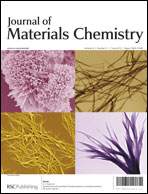This study involves the development of new solution processable organic small molecules for photovoltaic applications. We have rationally designed and synthesized two novel, symmetrical and linear D–A–D–A–D-type π-conjugated organic small molecules bearing a rigidly fused naphtho[1,2-b:5,6-b′]dithiophene core flanked by bithiazole (M3) or triphenylamine-capped thiophene(3-decanyl)-bridged bithiazole (M4) conjugated moieties through thiophene(3-decanyl) spacer. The resultant small molecules have been characterized by thermal analysis, UV-Vis spectroscopy, photoluminescence spectroscopy, X-ray diffraction, and cyclic voltammetry. Their applications in field effect transistors and solution processed bulk-heterojunction (BHJ) organic solar cells (OSCs) have also been explored. Due to the presence of an adequate number of 3-decanylthiophene moieties as short π-bridging units into the conjugated molecular backbone, both the small molecules have good solubility in common organic solvents and form highly ordered self-assembled π–π stacks in their solid states with long decyl chains organized by interdigitation. Additionally, they exhibit good thermal stability with decomposition temperatures exceeding 380 °C. Photophysical and electrochemical studies reveal that these molecular donors have comparable optical band gaps (∼1.99 to 2.02 eV) and nearly similar HOMO–LUMO energy levels, both of which are aligned with the PC61BM/PC71BM electron acceptors. The preliminary BHJ photovoltaic cells configured with the device structures of ITO/PEDOT:PSS/small molecule:PC71BM/Lif/Al were evaluated. The small molecule M3 was found to deliver the best power conversion efficiency of 1.09% when processing the active layer from chloroform solvent. In contrast, under identical device conditions M4 gave improved performance with a maximum efficiency of 1.62%. The morphological studies using atomic force microscopy showed that the PCE enhancement for M4 is mainly due to improvement in the nanoscale film morphology of the M4–PC71BM blend.
![Graphical abstract: Novel naphtho[1,2-b:5,6-b′]dithiophene core linear donor–π–acceptor conjugated small molecules with thiophene-bridged bithiazole acceptor: design, synthesis, and their application in bulk heterojunction organic solar cells](/en/Image/Get?imageInfo.ImageType=GA&imageInfo.ImageIdentifier.ManuscriptID=C2JM30934C&imageInfo.ImageIdentifier.Year=2012)
You have access to this article
 Please wait while we load your content...
Something went wrong. Try again?
Please wait while we load your content...
Something went wrong. Try again?
![Graphical abstract: Novel naphtho[1,2-b:5,6-b′]dithiophene core linear donor–π–acceptor conjugated small molecules with thiophene-bridged bithiazole acceptor: design, synthesis, and their application in bulk heterojunction organic solar cells](/en/Image/Get?imageInfo.ImageType=GA&imageInfo.ImageIdentifier.ManuscriptID=C2JM30934C&imageInfo.ImageIdentifier.Year=2012)

 Please wait while we load your content...
Please wait while we load your content...